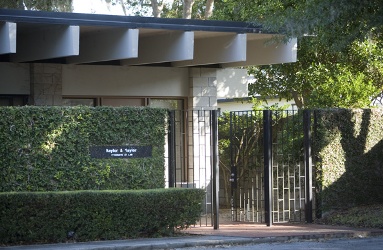Kaylor Law Office
Structure 6 (A1)
525 Avenue G NW
Year Built 1987
« back to structures
« back to works

Tour Narrative
Ample parking sets the 1987 law office of Mark Kaylor off the street, but within close range of Gene Leedy's office next door. Built nearly 30 years apart, this building is as true to Leedy's philosophy of modern architecture as the first.
more »
Set solidly and elegantly amongst the stately oaks, this law office is a strong example of how a building should relate physically to its surroundings and its purpose. Note how this is a structure meant to make a statement and meet the specific needs of its patrons. The prominent double T beams that overshadow the almost hidden iron gated entrances will become familiar to you on this tour. The front courtyards mask the outsider's view of the interior spaces, creating an important sense of confidentiality and discretion.
And as with all of Gene's work, the interior design of this building is just as important as the exterior. So important, in fact, that Leedy actually includes the placement of furnishings in his blueprints. To furnish this space, he put Rosemary Gillett, his long-time interior designer of choice, on the assignment. Always in sync with Gene's specifications, she took advantage of a unique opportunity and rescued top quality classic modern furniture from the demolition of Orlando's Florida Gas Building. While our society has the instant gratification of Rooms to Go, these pieces were meant for rooms to stay. Gillett's complimentary interior preservation efforts venerated Kaylor's office space, while enhancing the exterior to interior flow, so important to Leedy designs.
Max Strang, who was raised in a Gene Leedy home, has become a successful architect himself. Strang reflects on the special quality of Leedy's work, the demand for respect, and the preservation of this office and other buildings like it:
"Architects have many roles. We have to put on many hats. First and foremost we have a distinction of looking out for the public health, safety, and welfare. And that buildings don't collapse around us, so to speak. And that our buildings meet codes and all that stuff. But that is more of the mundane aspect. You know when a building becomes more than a building and a work of architecture. That's when you know the architect got it right. And nine times out of ten, probably more often than that, Gene's buildings are much more than a building. They have a certain inherent quality that elevates it to a work of architecture. And that is worth preserving."
Now, turn around in the parking lot and appreciate these three worthy works of architecture as you continue on the tour.




